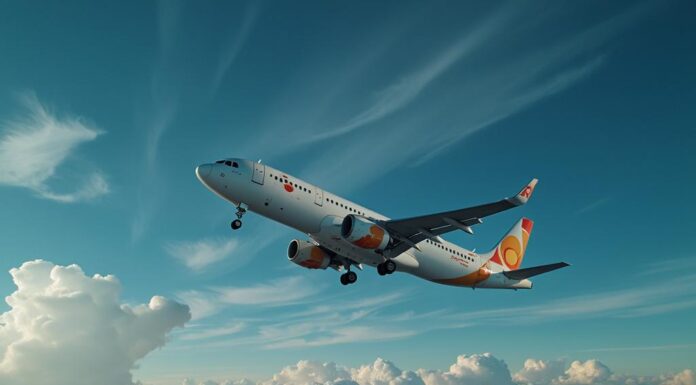Introduction: A Closer Look at the Impact of Carbon Offsets in Aviation
In recent years, as global awareness of climate change has intensified, the aviation industry has been under increasing pressure to reduce its carbon footprint. Airline carbon offsets have emerged as a popular solution touted by companies to achieve ‘carbon-neutral’ flights, allowing passengers to pay extra to supposedly neutralize their share of a flight’s emissions. This report delves into whether these initiatives stand up to scrutiny or merely serve a cosmetic purpose, embellishing the stark realities of greenhouse gas emissions.
Carbon Offsetting: A Mere Drop in the Ocean?
Recent findings suggest that only 36% of surveyed individuals believe current airline offsetting schemes positively impact the environment. This statistic arises amid broader discussions on the true efficacy of carbon offsets in mitigating aviation emissions. Experts argue that such schemes often foster a false narrative of guilt-free travel, potentially leading to an increase in flight demand rather than a decrease in emissions.
A study by TU Delft and Radboud University in 2025 highlighted this paradox, revealing that carbon offsetting offers could indeed encourage more flying—counteracting their intended purpose by easing passenger guilt and inadvertently increasing overall emissions.
The Public’s Stance and EU Regulatory Actions
Public skepticism is considerable; only 38% are willing to pay more to mitigate their emissions through these programs according to a Royal Aeronautical Society survey in 2025. This limited consumer support underscores a critical need for more effective and transparent mitigation strategies. In response, the European Commission has taken definitive steps by planning to incorporate all aviation emissions under its Emissions Trading System (ETS) by 2026, emphasizing direct emission cuts rather than reliance on offsets.
Technological Hopes Versus Realistic Solutions
With Sustainable Aviation Fuels (SAF) and advanced contrail avoidance strategies on the rise, there remains a glimmer of hope for significant emission reductions. However, experts like those from Carbon Market Watch caution against overly relying on these technologies as silver bullets. The critique from December 2024 argues that while technologies like SAF are necessary, they alone cannot offset aviation’s growing environmental impact if scalability and lifecycle emissions issues aren’t resolved.
Contrails and Non-CO2 Effects: The Overlooked Climate Agents
One often overlooked aspect is the non-CO2 effects of flying, such as contrail formation and nitrogen oxides (NOx), which significantly contribute to atmospheric warming. Addressing these impacts involves not just advanced technological interventions but also operational changes like optimizing flight paths to minimize contrail formation—a strategy still limited in its application.
Assessing CORSIA’s Integrity Amidst Escalating Challenges
The International Civil Aviation Organization’s CORSIA initiative aims for carbon-neutral growth post-2020 but has been plagued by criticisms concerning the quality of offsets and susceptibility to scandals involving credit integrity. With phases set to become mandatory by 2027, transparency and stringent regulatory oversight will be crucial in bolstering CORSIA’s credibility and effectiveness.
Beyond Offsetting: Envisioning Genuine Sectoral Decarbonization
Fundamental shifts towards real abatement options remain paramount. This encompasses not just adopting next-gen fuels but rethinking operational efficiencies and possibly embracing degrowth strategies where market forces alone don’t suffice.
KEY FIGURES
- Only 36% of respondents viewed current airline carbon offsetting schemes as having a positive environmental impact, with nearly half accepting fossil fuel use offset by carbon capture as an “acceptable” Net Zero pathway (Royal Aeronautical Society survey, 2025)[2].
- Just 38% of passengers were willing to pay more to reduce flight emissions, indicating limited consumer support for offsets (Royal Aeronautical Society survey, 2025)[2].
- A 2025 study found that carbon offsetting can increase demand for flying by creating a false sense of guilt-free travel, potentially undermining emission reduction efforts[1].
- The EU plans to move aviation emissions fully to auctioning under its ETS by 2026, reducing free allowances by 50% in 2025, emphasizing direct emissions cuts over offset reliance[4].
RECENT NEWS
- “Why carbon offsetting can encourage more flying” (July 2025) — Research from Delft University of Technology showed that offsetting incentives may paradoxically lead to more flights by easing passenger guilt, thus worsening climate impact[1].
- RAeS public survey on aviation decarbonization (April 2025) — Revealed public skepticism about offset schemes and more support for frequent flyer taxes and sustainable aviation fuel (SAF) investments than offsets[2].
- Carbon Market Watch critique (December 2024) — Highlighted the aviation industry’s overreliance on offsets and carbon removals as “false solutions” distracting from real emission reductions[3].
- European Commission update (May 2025) — Detailed tighter EU ETS aviation rules and ongoing CORSIA implementation, focusing on mandatory offsetting of emissions growth above 2020 levels with scrutiny on offset quality[4].
STUDIES AND REPORTS
- TU Delft, Radboud University (2025): Found that carbon offsetting schemes can encourage more flying by reducing passenger guilt, thus potentially increasing emissions rather than neutralizing them[1].
- Royal Aeronautical Society (2025): Surveyed public attitudes showing limited confidence in offsets and stronger support for operational and policy measures like SAF, frequent flyer levies, and taxes earmarked for decarbonization[2].
- Carbon Market Watch (2024): Reported that CORSIA and other offset schemes often rely on low-quality credits lacking additionality, permanence, and proper accounting for non-CO2 effects, undermining genuine climate benefits[3].
- Nature Communications (2025): Analyzed airline communication practices on voluntary offsets, revealing frequent greenwashing and lack of transparency about offset limitations[5].
TECHNOLOGICAL DEVELOPMENTS
- Sustainable Aviation Fuels (SAF): Growing focus on SAF as a partial emissions reduction pathway, but significant challenges remain with feedstock availability, lifecycle emissions, and scalability[2].
- Contrail Avoidance Strategies: Research into flight path optimization to reduce contrail-induced warming is emerging but still limited in deployment[3].
- Advanced Emissions Monitoring: Enhanced MRV (monitoring, reporting, verification) frameworks under EU ETS and ICAO CORSIA aim to improve offset credibility and reduce fraud risks[4].
- Carbon Removal Technologies: Industry discussions increasingly center on carbon dioxide removal (CDR) methods, though these are criticized as potential distractions from needed direct reductions[3].
MAIN SOURCES
- https://www.tudelft.nl/en/2025/tbm/why-carbon-offsetting-can-encourage-more-flying-even-among-the-environmentally-concerned — TU Delft study on behavioral effects of offsets[1].
- https://www.greenairnews.com/?p=7118 — Royal Aeronautical Society survey on public attitudes towards aviation decarbonization[2].
- https://carbonmarketwatch.org/2024/12/16/unsafe-for-takeoff-false-solutions-will-not-help-aviation-sector-navigate-climate-crisis/ — Critical analysis of aviation offsetting and carbon removal schemes[3].
- https://climate.ec.europa.eu/eu-action/transport-decarbonisation/reducing-emissions-aviation_en — European Commission overview of aviation emissions policies including EU ETS and CORSIA[4].
- https://www.nature.com/articles/s44333-025-00027-7 — Scientific study on airline carbon offset communication and transparency[5].
Other references:
tudelft.nl – Why carbon offsetting can encourage more flying
greenairnews.com – RAeS study shows public concern about aviation …
carbonmarketwatch.org – Unsafe for takeoff: False solutions will not help aviation …
climate.ec.europa.eu – Reducing emissions from aviation – European Commission
nature.com – Assessing airline communication for voluntary carbon offsets
icao.int – Source
aviationbenefits.org – Source
climate.ec.europa.eu – Source
icao.int – Source
easa.europa.eu – Source
faa.gov – Source
icao.int – Source
nature.com – Source
examples.tely.ai – Source
nature.com – Source
tandfonline.com – Source
icf.com – Source
sciencedirect.com – Source
sciencedirect.com – Source



